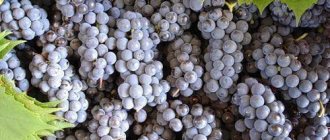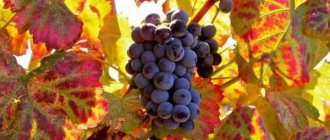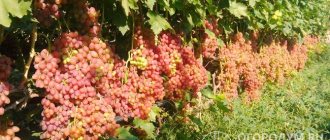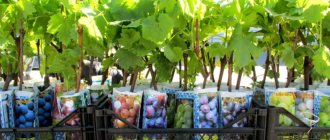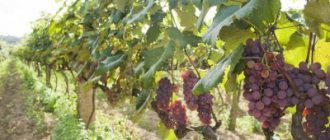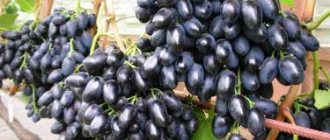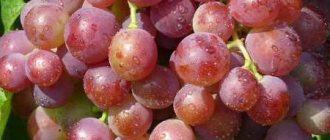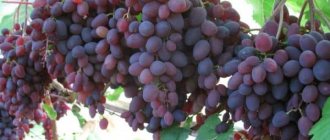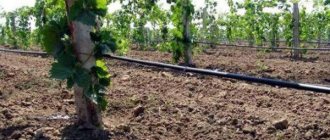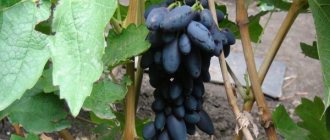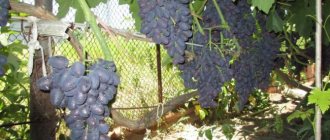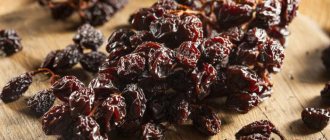Isabella grapes owe their popularity to their ability to adapt to different climatic conditions. An unpretentious plant with “American roots” in all respects, the ancestor of which is considered to be Vitis vinifera, was brought to Europe in the 17th century. For winegrowers it became a “lifesaver” in low-yield years, and for winemakers it presented original tastes and aromas. For three centuries, the plant, the result of crossing wild crops, has never ceased to interest breeders, which is reflected in the constant updating of isabella varieties.
Description of Isabella grapes
This grape variety received its current name in 1816. His “godfather” was the Brooklyn gardener William Price, who immortalized the name of his friend’s wife, the first beauty of Dorchester (North Carolina), Isabella Gibs.
The Isabella grape variety has tall, dense bushes, which makes it attractive to landscape designers. At first, he is not pleased with the speed of growth. However, 3 years after planting its branches, the plants lengthen by 3–4 meters annually. Young shoots are characterized by a greenish-crimson color, while the old vine remains gray-brown.
The dark green three-lobed leaves of the grape are gray-white on the reverse side. By autumn, Isabella's foliage turns golden.
Cylindrical, in the shape of an inverted cone, the clusters do not have a high density of berries. With an average weight of 200 to 250 g, in particularly fruitful years, the weight of individual specimens exceeds 2 kg. Each shoot bears an average of 3 clusters.
With a diameter of about 18 mm, the weight of berries of the Isabella variety reaches 3 g. Dark blue, oval-shaped grape fruits are distinguished by juicy pulp with sparse seeds. The significant sugar content (15.4–18%) as well as the original sourish-sweet taste make the variety attractive to winemakers. The period between flowering and harvesting takes about six months.
Isabella grapes are common in the southern regions (Crimea, Caucasus). Due to its high frost resistance, the variety is actively moving into the central part of Russia; it can be found in the Urals and even in Siberia.
Isabelle grape varieties
Constant selection of Isabella grapes contributes to the emergence of new varieties with improved beneficial properties.
A plant has been bred from black grapes, the clusters of which are created with amber-colored berries. In many characteristics, the Isabella Belaya grape is superior to its ancestor, and its appearance and taste increase the attractiveness of the variety as an exquisite dessert.
Among the Isabella grape varieties common in Russia, the leading positions remain with Lydia and Seneca. However, they are gradually being replaced by new representatives of the Isabella dynasty, which have a more pleasant taste, lack slimy pulp, and are distinguished by a short ripening period of berries and other useful qualities. These varieties include:
- Simone;
- Era;
- Minsk pink;
- Supaga;
- Sukribe;
- Alden;
- Alwood;
- Zilga;
- Agra et al.
Not distinguished by large berries and clusters, the new isabella varieties provide a stable harvest and do not create difficulties in care, which makes them attractive for growing in summer cottages in the middle zone.
Of no less interest are the Isabelle sultanas, which are represented by Venus, Reliance Pink Seedlis, Romulus and Einseth Seedlis. The grapes of these varieties are not inferior in size to Isabella and Lydia. They are completely seedless, contain a high percentage of sugar, and are resistant to mildew.
Drought resistance frost resistance
Low drought resistance is one of the few disadvantages of the variety. At the same time, Isabella grapes thrive in areas with high humidity. The plant tolerates cold easily. Its roots and vines do not need to be covered when the air temperature does not drop below 7–8 degrees below zero.
History of varieties, growing regions
Each of these two varieties has its own Wikipedia page, where you can gain knowledge about their origin. The history of Isabella and Alpha is practically the same: they were bred in America, they have a common “parent” - this is the popular American species Vitis labrusca, which is why the varieties are so similar in appearance. But to obtain Isabella, Vitis labrusc was pollinated, and naturally, with Vitis vinifera (cultivated grape), and for Alpha - with V.riparia (wild grape).
Isabella, Alpha and other hybrids obtained with the participation of Vitis labrusca were banned from use in commercial winemaking. It is believed that the wines made from them contain unacceptable doses of the poisonous alcohol methanol. However, small farmers and amateur gardeners grow these varieties, prepare and drink wines and claim that the information about the increased content of harmful substances is a myth.
Video: Isabella - grapes for wine
Isabella is widespread in Georgia, Azerbaijan, Moldova, Crimea, Krasnodar Territory, Dagestan and the Volga region. Alpha grows well in the Moscow region, in the south of Siberia, and is zoned for the Primorsky Territory and the southern regions of Belarus.
Chemical composition and calorie content
The chemical composition of Isabella grapes is saturated with useful micro- and macroelements, among which there is a noticeable predominance (per 100 g):
- potassium (225 mg);
- calcium (30 mg);
- sodium (26 mg);
- phosphorus (22 mg);
- magnesium (17 mg);
- silicon (12 mg);
- sulfur (7 mg), etc.
The vitamin component of the variety is represented by a significant content of ascorbic and folic acids, beta-carotene, tocopherol, choline, riboflavin, etc.
Grapes are a healthy and nutritious product, the excess consumption of which is not accompanied by weight gain. The energy value of Isabella variety berries is 80 kcal per 100 g, which is due to the content of:
- proteins – 0.6/100 g;
- fat – 16.8/100 g;
- carbohydrates – 0.2/100 g.
Grapes also contain fatty and polyunsaturated acids.
Isabella grapes beneficial properties
The beneficial properties of Isabella grapes are determined by the content of valuable substances, some of which are not produced by the body and require external supply.
Pectins and anthocyanins strengthen the immune system, protect the body from harmful bacteria, and prevent premature aging. The daily requirement of these elements reaches 155–200 mg, which is covered by consuming 300–350 g of fresh grapes. Antioxidants are concentrated in the skin and seeds of the berries.
The fruits of dark isabella varieties increase hemoglobin, which is especially useful for pregnant women and people with blood pathologies. Having a beneficial effect on blood vessels, grapes help lower blood pressure and improve heart function. Sugar, acids. vitamins relieve fatigue and restore the body after significant physical exertion. The peels and seeds of grapes remove waste and toxins and have a beneficial effect on the functioning of the gastrointestinal tract.
Thanks to the food acids contained in Isabella berries, cholesterol levels are reduced, metabolic processes are normalized, and fat cells are burned. At the same time, grapes perfectly satisfy hunger without the risk of gaining excess weight.
In addition to the berries, the leaves and vine of Isabella have beneficial properties. Tannins, vitamins, minerals, and vital acids are concentrated in these parts of the plant. Grape leaves are used as effective compresses to reduce fever, relieve swelling and pain from injuries.
Decoctions of young vines and leaves are used as powerful antiseptics that disinfect wounds and stop purulent processes. The beneficial properties of such decoctions are also manifested in the expectorant effect, which is used in the treatment of influenza, sore throat and other respiratory diseases.
Landing rules
Before planting Isabella, it is necessary to prepare the soil, which is done a month earlier. Work begins with digging a hole, the diameter and depth of which must be more than 80 cm. The bottom is lined with drainage, on top of which soil mixed with superphosphate is placed. The third layer is represented by ordinary soil, and the finishing layer is soil saturated with peat and humus. Planting stages:
- The prepared pit is filled with water (8–10 buckets).
- A support is placed in the center of the hole. Next to it, a small elevation is erected from the ground, on which a seedling with straightened roots is placed.
- Soil is poured into the hole, the top layer of which is leveled with the root collar.
- After compacting the soil, the grapevine is cut into 5–6 buds, then tied to a support.
- The procedure ends with abundant watering of the plant, followed by mulching the soil, which protects the roots of fragile grapes from sunlight.
Selecting a location:
As mentioned above, Isabella is not picky about the soil. It prefers to grow in fertile soils with low acidity levels, but can also grow well in any other area.
Isabella grapes prefer open, well-ventilated sunny areas or partial shade. A suitable location would be south or west. Do not plant your grapevine next to fences, walls, where groundwater passes close to the surface of the earth, in lowlands where water can stagnate after rain or melting snow. Areas with high acidity levels and those blown by strong winds are also not suitable.
You should not plant the plant in places where water will drip on top of them, near fruit trees. A distance of 5 to 6 meters must be maintained between the vine and other garden crops. The fact is that by leaving less distance, the vine can harm other plants, since it has very strong roots that can strangle them.
Interesting fact! The stems and leaves of the vine have medicinal properties known throughout the world.
Caring for Isabella grapes
Before caring for Isabella grapes, it is necessary to study the characteristics of the variety. Since the plant does not tolerate drought, care consists of abundant watering, the intensity of which increases in spring and autumn, and also when there are 7–10 days left before flowering.
With the beginning of the growing season, grapes need fertilizing in the form of nitrogen. The formation of inflorescences and berries is accompanied by the addition of phosphorus-containing and potassium fertilizers to the soil, to which zinc and boron are added. With the onset of autumn, the grapevine prepared for wintering is fed with copper products.
Like other grape varieties, Isabella needs pruning. Spring-summer pruning comes down to getting rid of damaged and weak shoots. The autumn procedure is aimed at forming the crown of the bush.
To protect the plant from rodents, the vine is wrapped in non-woven materials, and pesticides are scattered under the winter shelter. The abundance of essential oils reliably protects Isabella from insects.
Watering:
Watering is necessary for grapes, especially at the initial stage of growth. Once you have planted your seedlings, they need abundant and frequent watering. This will help the young plant adapt to new conditions, quickly begin to develop its root system and begin to grow. Watering should be done at least twice every 7 days, using a bucket or two of water. At the same time, make sure that there is no stagnation, as this can be more dangerous than a lack of water.
The watering scheme changes for adult bushes. They are watered only when necessary. As a rule, one bucket once a week is sufficient.
During the period when fruits are actively forming and growing, the soil should never be dry.
It is recommended to water in the evening.
Two weeks before the expected harvest, watering should be stopped to give the grape clusters the opportunity to ripen and not burst.
The next watering is carried out before the onset of cold weather, when the entire crop has been harvested. To do this, 70 liters of water are poured under each bush, this helps the plant recover and gain strength before the start of winter.
Interesting to know! In the east, grape leaves are used to prepare dolma, which is also loved in our country.
Harm and contraindications
To determine whether the Isabella grape variety is harmful to the body, it is necessary to clarify the conditions for its use. The dangers and undesirable consequences are:
- significant sugar content, which threatens weight gain;
- excess calcium, which provokes an increase in blood pressure;
- a large amount of carbohydrates, the breakdown of which in the stomach is accompanied by flatulence.
Isabella fruits are contraindicated:
- for individual intolerance, allergies and peptic ulcers;
- obese women in the final stages of pregnancy;
- breastfeeding mothers and children under three years of age.
The variety is not recommended for diabetics, hypertensive patients, or people with high stomach acidity.
What type does it belong to?
“Isabella” is a technical , late-ripening, unsheltered grape variety, suitable for fresh consumption, but more often used as a raw material for the production of juices and light table wines.
In private households it is used for making jam, jam, compote. Technical varieties also include Levokumsky, Bianka and Augusta.
Productivity, taste qualities and good resistance to most typical crop diseases have made the variety desirable for many winegrowers interested in growing stable, large-volume harvests.
Resistant to mildew , phylloxera , and oidium , but susceptible to chlorosis and anthracnose.
